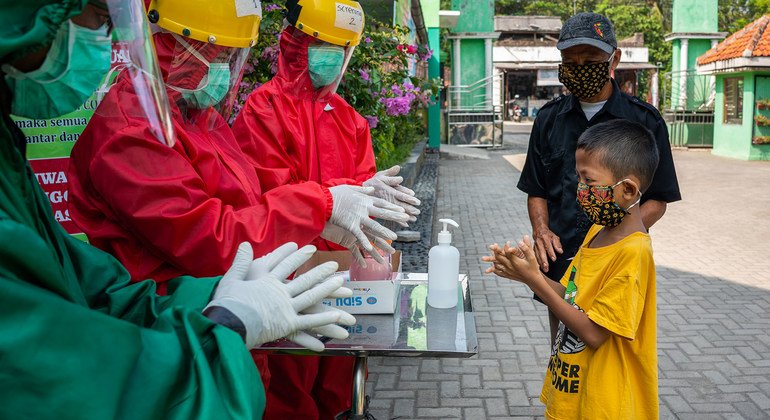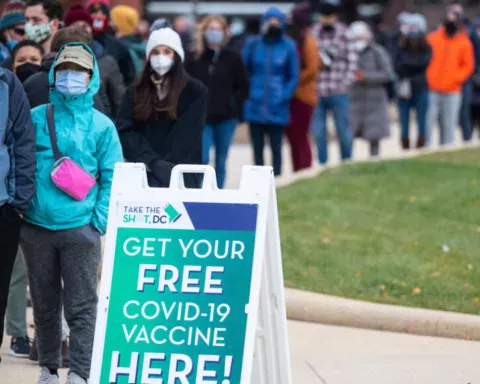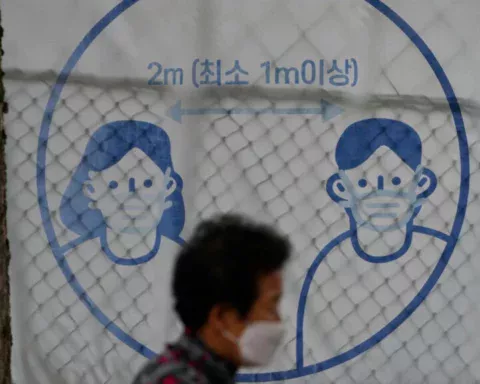The coronavirus disease (COVID-19) pandemic has compelled government authorities to design and implement policy responses in a rapidly evolving situation. Many countries have introduced containment strategies of varying degrees and duration. Some have begun relaxing these measures, while others are reinstating restrictive policies as they experience a resurgence.
Epidemic control policies come with social and economic consequences. Thus, there is hesitation over what minimum measures should be retained, what measures can be eased, and in what sequence to pave the way for cautious economic reopening.
The unpredictability of the COVID-19 trajectory leads to ambiguity around the optimal policy regime for managing and controlling infection and progressively allowing economic activities. Nearly all governments, including those in Southeast Asia, face this immense challenge.
Recent experience in India highlights the need for COVID-19 forecasting models to guide suppression policies. Suppression through an adaptive control strategy could allow countries, states, or cities to bring infection rates under control while allowing modest levels of economic activity. A modelling framework could also be instrumental for targeting supplies of an eventual vaccine, which will be quite limited in the initial stages of introduction.
This policy brief is based on a presentation by Anup Malaniat the Policy Actions for COVID-19 Economic Recovery (PACER) Dialogues organized by the Asian Development Bank.
Challenges
The crisis has forced governments to confront multifaceted challenges with completely new policymaking approaches under conditions of uncertainty. Governments have pursued policies with limited information, and with inadequate consideration and analysis of the benefits and trade-offs of different containment measures.
When the World Health Organization (WHO) declared COVID-19 as a pandemic, several countries imposed lockdown measures to stem the spread of the virus. However, most of these nations—especially those with inadequate resources—can not afford to sustain extreme restrictions that are crippling their economies.
Another issue that has complicated matters for governments is the lag between when policies are enacted and when they affect the disease, as well as a lag between dates of infection and death. Looking at current infections or deaths for policymaking can lead to errors. One may underestimate or overestimate the cases that are actually occurring when policy finally has an impact on cases. Instead, governments should generate forecasts to determine what changes need to be made today.
Key Considerations
Countries have different sociopolitical contexts, health systems, resources, and unique epidemiological challenges. Thus, their containment strategies ought to be targeted and localized. More importantly, they need to pursue evidence-based frameworks to better enact policies during this pandemic that improve health outcomes while reducing economic burdens. As such, accurate and timely data is fundamental to strengthening policy measures, especially in a situation like the COVID-19 crisis that requires science-based and targeted responses with due consideration for both immediate and long-term consequences.
Whether the pandemic severity is high, medium, or low in a given location, testing remains critical to obtain the necessary data for detecting cases and isolating patients. There is a tendency to mainly test symptomatic individuals, but asymptomatic carriers must also be identified to minimize the chain of transmission.
Crucially, timely reporting of these tests ensures that data is up-to-date. This is critical for generating reliable forecasts aimed at identifying emerging hotspots and making policy refinements according to changing local conditions.
Along with virological testing, serological testing can provide a vital piece of the puzzle for policymaking in the context of COVID-19. This type of test shows evidence of past exposure and infection, helping to determine the level of immunity in a population. Such information helps authorities assess the vulnerability of a particular community and will prove valuable for allocating the constrained supplies of a future COVID-19 vaccine.
Adaptive Control for Suppression Policies
As more countries build their domestic capacity for testing, they become armed with more data that could help them predict the course of COVID-19 and integrate adaptive control into their policy responses.
Adaptive control is a flexible counter-cyclical policy approach, whereby different areas release from lockdown in potentially different gradual ways, depending on the local progression of the disease. It requires flexibility to decrease or increase social distancing in response to observed and projected dynamics of the outbreak.
Adaptive control has three basic principles. First, suppression policy should have a clear epidemiological target or objective. For example, a target may be related to lowering the reproductive rate (Rt), which refers to transmissibility. Setting a target on Rt captures the need to control the momentum of the infection.
Alternatively, an objective could be focused on keeping the trajectory of deaths low or ensuring adequate healthcare capacity, such as the ratio of hospital beds to hospitalizations. The focus on deaths overcomes the problem that the number of cases is a function of testing policy, which may in practice be inadequate.
When setting targets, policymakers should account for incentives to manipulate data. If the target is associated with the level of COVID-19 cases, there might be an inclination to conceal true data for fear of a lockdown. Therefore, it is recommended to combine objectives with a testing rate requirement to ensure data integrity.
The second principle is to measure targets locally and periodically since Rt can vary across locations and change over time. Regular monitoring at the local level allows policymakers to recalibrate policy responses based on recent data from a particular community.
The third principle is to map targets to suppression policies. For instance, if Rt is below 1, which is considered an optimal level of transmissibility, restrictions and social distancing policies could be relaxed or lifted accordingly. An Rt above 2 warrants extreme policies on mobility to curb the outbreak.
Table 1: COVID-19 Restrictions Based on the Transmissibility Level
| Target/Trigger | Social Distancing Policy |
|---|---|
| 2 ≤ Rt | Maximum lockdown observed |
| 1.5 ≤ Rt < 2 | 2/3 to maximum amount of lockdown |
| 1 ≤ Rt < 1.5 | 1/3 to maximum amount of lockdown |
| Rt < 1 | Minimum lockdown, voluntary social distancing |
Forecasting for Vaccination Policies
While there are global initiatives such as the COVID-19 Vaccine Global Access (COVAX) to ensure equitable access to supplies, these do not offer a framework for within-country distribution policy. To address this, the vaccination target should be devised using forecast modelling of Rt and serological studies. By identifying a portion of the population with prior infection, policymakers could account for individuals with acquired immunity in their targets. Testing for T cells, instead of antibodies, is strongly recommended as it is better suited for detecting immunity.
It is important to note that the level of vaccine efficacy based on clinical studies should be factored into the calculation of targets. Thus, a lower efficacy would lead to a higher target. Distribution policy should also be localized as risks and herd immunity threshold vary by location. Since the rate of a population’s exposure to COVID-19 increases over time, serological testing should be done close to the date of vaccination. While there are uncertainties on when a vaccine becomes available and when it could be administered, surveillance is a feasible approach that could be done repeatedly to assess the incidence of infection.
Moreover, distribution policy should be reflective of the main goal of vaccination. When a goal is centered on health, vaccine prioritization should account for individual-level attributes that are easy to identify, such as age, gender, occupation, etc. to implement a model at scale. Based on individual-level data, estimates on Rt, probability of infections, and deaths per category can be determined, thereby allowing an evidence-based priority allocation methodology for vaccination.
Policy Implementation
Experience in India has shown that a gradual and localized approach allows for safer reopening and reductions of infection rates.
Using adaptive control, a strategy was developed to inform state policy in India with three main parts: (i) gradual introduction of activities; (ii) setting and tracking epidemiological targets, such as reducing the Rt below 1, and adjusting social distancing every week or two to meet those targets; and (iii) adoption of different policies in different districts or cities based on local conditions.
An execution plan was also devised with four steps: (i) identifying gaps in existing data and decision-analysis tools; (ii) gathering more comprehensive COVID-related data to fill gaps in existing data; (iii) building evidence-based models of epidemiological outcomes and economic activity to address gaps in existing decision-analysis tools; and (iv) leveraging the epidemiological and economic outcomes to extract actionable recommendations from data.
On 24 March, India announced a nationwide lockdown—known as Lockdown 1.0—one of the most severe shutdowns worldwide. On 21 April, the government announced Lockdown 2.0, which allowed some states to relax controls in certain places. Adaptive control and Lockdown 3.0 commenced in early May, introducing the idea of zoned shutdown and calibrating policies according to local risk.
The Ministry of Home Affairs, with assistance from the Ministry of Health, Family and Welfare, issued an order that classifies districts across India based on their recent case counts.
Table 2: Classification of Districts Based on Case Counts
| Zone Category | Pandemic Severity |
|---|---|
| Red | Sizable number of cases detected or areas declared as hotspots |
| Orange/Yellow | Few cases found with no increase in the number of infections |
| Green | No confirmed cases in the last 21 days |
Green zones were allowed to begin all activities except air and inter-state bus and rail transport and opening of schools, hotels, malls, etc. while red zones were required to maintain stringent limitations. All other districts were classified as orange/yellow zones, which had to limit local taxis and local bus capacity. Within each of these color-coded zones, states may establish “containment zones” as small as a building, floor or even a home, which would be subject to even more severe restrictions than red zones.
Zone classification with the corresponding Rt determined the kind of restrictions placed on the movement of people and supply of goods in a district. Red was for full lockdown or no release, orange and yellow for 1/3 to 2/3 step towards full release, respectively, and green for a full release.
Table 3: Restrictions Based on Zone Classification
| Rt | Zone | Policy/Release | Travel to/from other districts |
|---|---|---|---|
| 2 ≤ Rt | Red | None | None |
| 1.5 ≤ Rt < 2 | Orange | 1/3 | None |
| 1 ≤ Rt < 1.5 | Yellow | 2/3 | None |
| Rt < 1 | Green | Full | Only other green districts in state |
On 17 May, the Ministry of Home Affairs announced Lockdown 4.0, which allowed states to determine which districts fall under a zone category. This enabled local authorities to balance local infection risk against local economic impact. Lockdown 5.0 on 8 June allowed a phased economic reopening of all areas outside the containment zones.
Outcomes
Simulations based on the susceptible-infected-recovered (SIR) model show that adaptive control allows states in India to contain their infection rates while facilitating modest levels of economic functions.
In Bihar, which is the third-largest state and home to 100 million people, projections on the number of cases per district with policy simulations were conducted every 2 to 3 weeks. Authorities coordinated with local officials based on the information provided, including emerging “hot” regions or where infections are growing rapidly (darker shades of blue on the map below), to determine which districts had to tighten controls.
Figure 1: Districts with Rapidly Increasing Infections

Dialogue with officials also provided an opportunity to offer guidance on best practices, including controlling the spread of the virus with labor migration and conducting serological testing with limited resources and capacity.
The graph below shows the simulations in Bihar, suggesting that adaptive control does better than either an immediate release from lockdown on 12 September or delaying it by another week. As illustrated, there is an initial increase in cases with adaptive control, but reduction is expected to occur over time and within a shorter duration.
Figure 2: Simulations in Bihar State
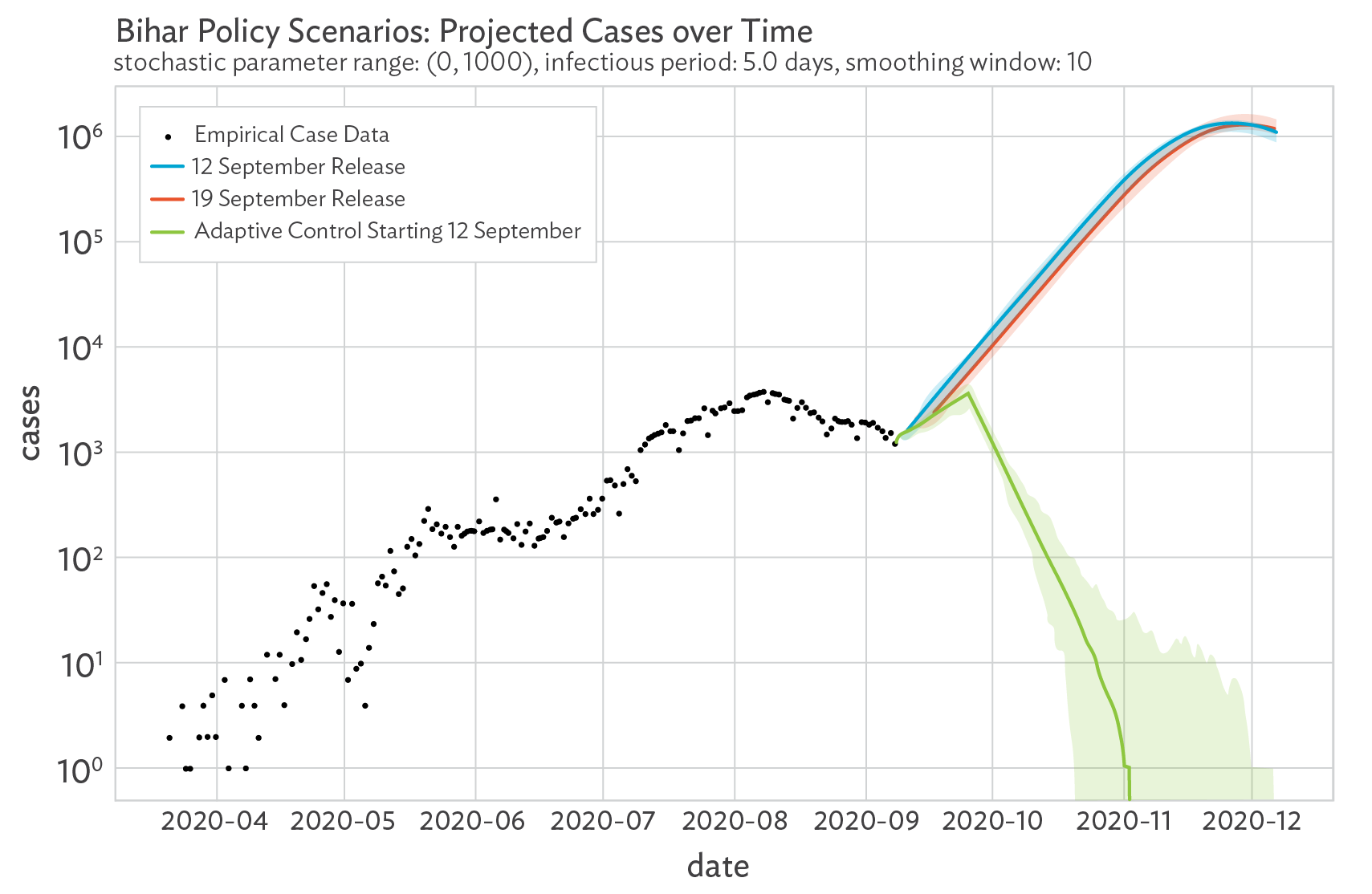
Similar work is being done across Indonesia. Forecasting is coupled with capacity building to enable local ministries and researchers to develop models themselves, and to make their data management more robust by enhancing their knowledge to spot data anomalies to make the necessary corrections in their models.
In Jakarta, simulations show a more positive scenario with adaptive control in comparison with immediate release and extended lockdown.
Figure 3: Simulations in Jakarta, Indonesia
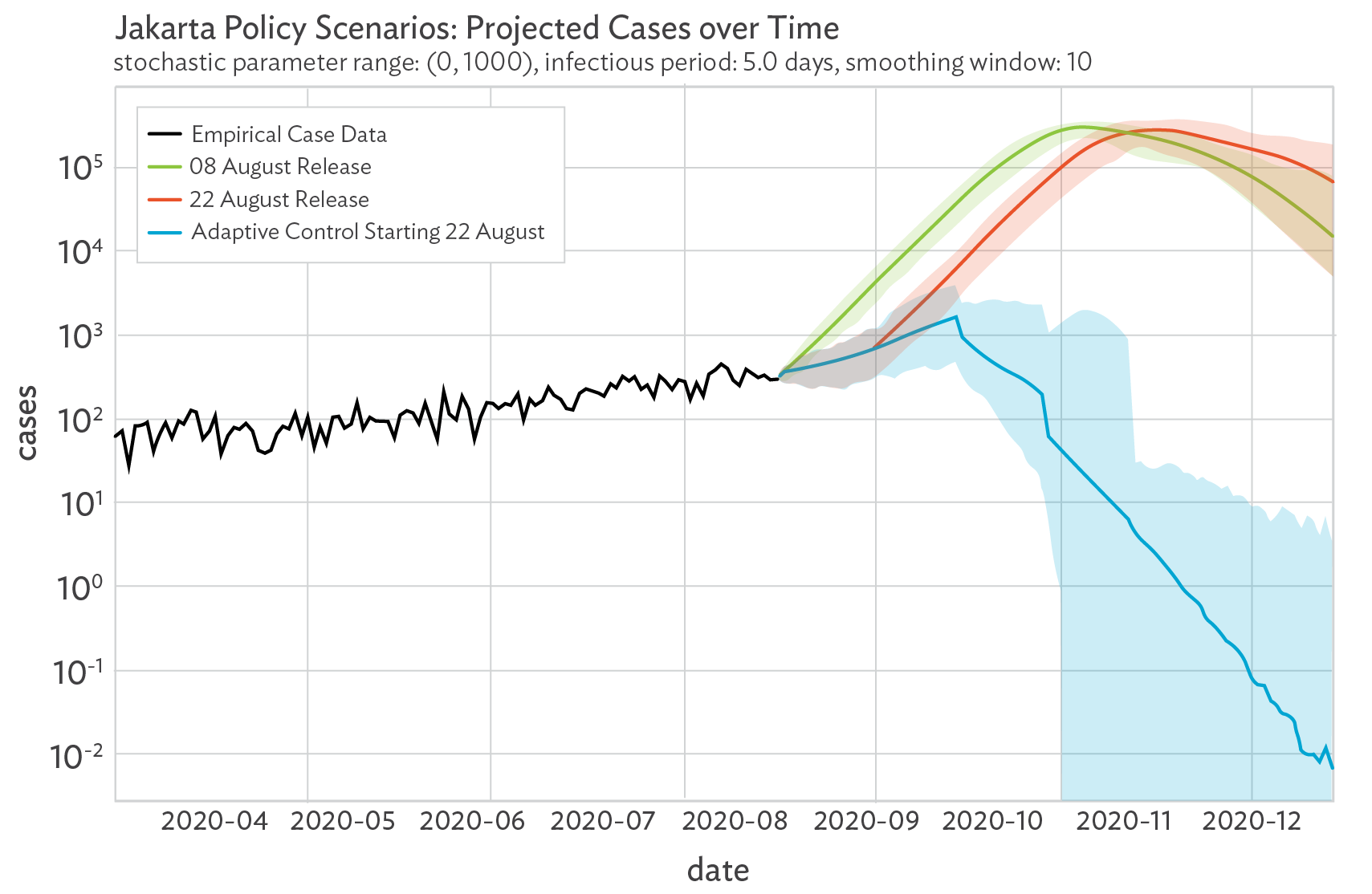
Recommendations
Expanding testing is critical.
While countries await a COVID-19 vaccine, testing on a larger scale would be required to gradually reopen economies. This enables a better understanding of the epidemiology as well as strategic planning for future healthcare needs.
In addition to testing for the virus, serological testing—which provides data on immunity—will be useful to inform a local community’s vaccination distribution policy. Since immunity levels change over time, it is important for serological testing to be done as close as possible to the date of vaccination.
Due to selection in testing and latency in reporting, it is important to correct for any flaws in data. A sound data science approach accounts for uncertainties in predictions, and a model should be constantly recalibrated as new data becomes available.
Continuously re-evaluate containment strategies and take account of health and economic consequences.
As lockdown fatigue and economic costs increase for some countries, governments are under mounting pressure to reopen economies. On the other hand, there are nations seeing re-emergence of cases and therefore must reintroduce stringent measures. Refocusing on targeted and localized approaches that measure both the value of economic and health considerations is crucial. Costs and benefits of different containment measures should be weighed when making decisions, and policies should be continuously adapted and refined with recent local data, which offers valuable insight into the dynamics of COVID-19.
Establish and communicate clear targets.
Setting clear targets helps shape sound policies for gradual reopening of economies, fosters accountability among governments, and facilitates better coordination among officials and the population. This also makes the public accountable to some degree and helps secure their buy-in as the achievement of goals and effectiveness of public health interventions are contingent on their behavior and adherence to policies. Finally, clear and transparent target-setting increases the legitimacy of containment measures.
Vaccine procurement and distribution should depend on local data and efficacy.
Because risks and immunity levels vary by location, vaccination targets and priorities should be based on local data. In addition, vaccine purchase decisions should depend on the cost of each death averted, efficacy, and price.

